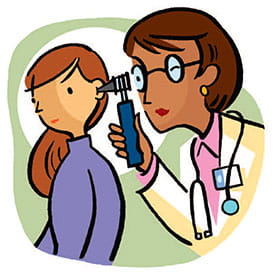The most important role of a parent or guardian is to help your child stay calm and relaxed before the test. The best way to help your child stay calm is for you to stay calm.
- Once your child has been registered for the surgery, a nurse or nurse practitioner will meet with you to take your child’s vital signs, weight and medical history.
- Your child’s surgeon will meet with you to discuss the surgery and answer any questions you might have.
- A pediatric anesthesiologist, a doctor who specializes in anesthesia for children, will meet with you and your child to review your child’s medical information and decide which kind of sleep medication your child should get. As the parent or legal guardian, you will be asked to sign a consent form before the anesthesia is given.
- If you wish, you may stay with your child until just prior to the sleep medication being given, and then you will be taken to the waiting room.
- You may bring along a "comfort" item—such as a favorite stuffed animal or "blankie"—for your child to hold during the surgery.
Going to sleep
- If your child is very scared or upset, the anesthesiologist may give a special medication to help him or her relax. This medication is flavored and takes effect in about 10 to 15 minutes.
- Younger children will get their sleep medication through a "space mask" that will carry air mixed with medication. Your child may choose a favorite scent to flavor the air flowing through the mask. There are no shots or needles used while your child is still awake.
- Older children may choose between getting their medication through the mask or directly into a vein through an intravenous (IV) line.
While asleep
- While your child is asleep, his or her heart rate, blood pressure, temperature and blood oxygen level will be checked continuously.
- Your child might be given an injection (shot) of pain medication.
The surgery
Using a microscope, the surgeon will gently clean inside your child’s ears, make a tiny opening in the eardrum and insert the tube. The surgery itself will take only about 10 to 15 minutes.
Waking up
When the surgery is over, the medications will be stopped and your child will begin to wake up.
- When your child is moved to the recovery room, you will be called to the bedside so that you can be there as he or she wakes up. It is OK to hold your child in your arms or on your lap.
- Your child will need to stay in the recovery room to be watched until he or she is alert and his or her vital signs are stable. The length of time your child will spend in the recovery room may be different from other patients because some children take longer than others to wake up after anesthesia.
- Children coming out of anesthesia have a variety of reactions. Your child might cry, be fussy or confused, feel sick to his or her stomach, or vomit. Very young children and infants might cry and "arch" their backs. These reactions are normal and will go away as the anesthesia wears off.
- You might notice a band-aid and a little red mark on your child’s arm from the injection of pain medication.
- Your child will have no memory of the surgery.
- In the recovery room, he or she will be encouraged to drink or to eat an ice pop.
Going home
After your child is discharged and goes home, he or she may still be groggy and should take it easy for the day.
- Your child may resume normal activities at the rate he or she is comfortable with.
- Your child may begin to eat and drink a little at a time and resume normal eating and drinking as long as he or she is feeling well. Clear liquids and bland foods may be given if he or she has an upset stomach.
- A nurse will call you 24 hours after the surgery to see how your child is doing.
Ear care at home
- If the surgeon prescribed ear drops after the surgery, follow the schedule. You can "pump" the drops into your child’s ear canal by gently pushing on the stiff part of the outer ear that covers the entry to the canal.
- Ear drainage may be gently cleaned from the OUTSIDE of the ear with cotton swabs dipped in hydrogen peroxide, or by using a washcloth with soap and water.
- The doctor might suggest that you use earplugs or a neoprene "ear band" cover when your child bathes or swims to keep dirty water out of the ear drums.
- NOTHING should be put directly into the ear canal except eardrops, and ony as directed by the surgeon.
- You might be asked to follow up with your child’s ENT doctor, or your pediatrician, to have the ear tubes checked after the surgery.









 At
At